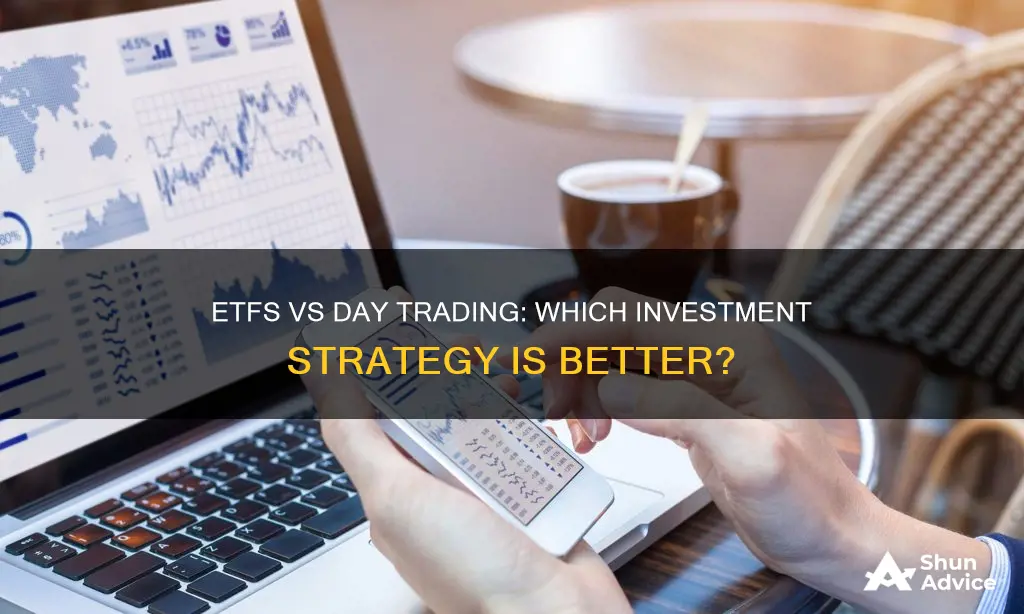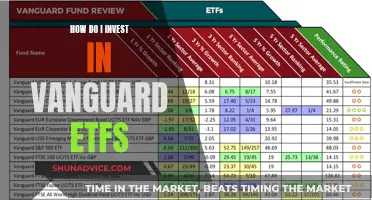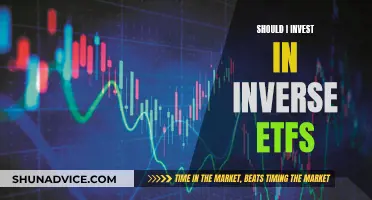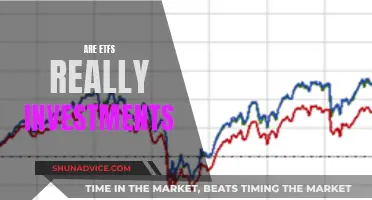
Day trading and investing in ETFs are two very different strategies. Day trading involves buying and selling stocks within a single day, attempting to profit from short-term price fluctuations. On the other hand, investing in ETFs is a long-term strategy, where investors buy and hold for extended periods.
Day trading ETFs can be lucrative due to the high volatility environment, allowing traders to buy and sell anytime during trading hours. ETFs also offer diversification, high liquidity, and low costs compared to mutual funds. However, day trading is generally not recommended as 95% of day traders lose money, and it incurs high tax rates on short-term gains.
Investing in ETFs, on the other hand, increases the chances of profit over time due to its long-term nature. ETFs provide intraday liquidity, cost-effectiveness, and effective hedging options, making them a brilliant mix of liquidity, transparency, and real-time trading.
Both strategies have their advantages and risks, and it's essential to understand these before deciding which approach to take.
What You'll Learn

Day trading ETFs: pros and cons
Day trading ETFs can be a lucrative strategy due to the high volatility environment, providing short-term opportunities to buy and sell anytime during trading. However, it is essential to weigh the pros and cons before venturing into day trading.
Pros of Day Trading ETFs:
- Intraday Liquidity: ETFs offer intraday liquidity, allowing traders to buy and sell shares throughout the trading day. This flexibility is advantageous for day traders who need to enter and exit positions quickly based on market conditions, enabling them to capitalise on short-term market movements.
- Cost-effectiveness: ETFs are generally more cost-effective than other investment vehicles. They have lower expense ratios compared to mutual funds, and trading costs are typically lower due to high liquidity and narrow bid-ask spreads. This helps day traders minimise expenses and maximise net returns, given they execute multiple trades per day.
- Effective Hedging: ETFs provide effective hedging options for day traders. The wide range of available ETFs allows traders to hedge against market risks by taking positions in specific sectors, commodities, or bonds. For example, a trader can use a bond ETF to hedge against equity market volatility or a commodity ETF to hedge against inflation.
- Leverage: Many ETFs offer leverage, amplifying potential returns for day traders. Leveraged ETFs aim to deliver multiples of the performance of the underlying index or asset. For instance, a 2x leveraged ETF seeks to provide twice the daily return of the target index.
- Broad Sector Exposure: ETFs provide broad sector exposure, allowing day traders to diversify their portfolios and reduce risk. By trading sector-specific ETFs, traders can focus on particular industries or market segments without selecting individual stocks, helping them capitalise on sector trends and mitigate the impact of poor performance in a single stock.
Cons of Day Trading ETFs:
- High Risk: Day trading is a high-risk endeavour, with an estimated 95% of day traders losing money. The short-term nature of day trading strategies makes it challenging to consistently earn stable profits.
- Taxes and Fees: Day trading incurs high tax rates on short-term gains, reducing overall profits. The frequent buying and selling of ETFs can result in significant transaction costs, including trading commissions and taxes at ordinary income tax rates, which are typically higher than long-term capital gains tax rates.
- Competition: When placing a market order, day traders compete with institutional investors and high-frequency trading machines. The probability of outperforming these sophisticated investors without possessing insider information is extremely low.
- Time Commitment: Day trading requires a significant time commitment, as traders need to monitor the market throughout the day to identify short-term opportunities.
- Emotional Strain: The fast-paced and volatile nature of day trading can lead to emotional swings and stress, especially when facing losses.
In conclusion, while day trading ETFs offers advantages such as liquidity, cost-effectiveness, and hedging options, it is a risky strategy with potential drawbacks, including high taxes, fees, and competition from institutional investors. It is crucial to carefully consider these pros and cons before engaging in day trading ETFs.
Invest in Philippines ETFs: A Beginner's Guide
You may want to see also

ETFs vs. common stocks for day trading
Day trading is a risky strategy where traders attempt to profit by opening and closing multiple trade positions within a day. While it is possible to make money day trading, it is not profitable for the vast majority of traders. Day traders usually close all their positions at the end of the day and do not carry them over to the next.
When deciding between investing in exchange-traded funds (ETFs) or common stocks for day trading, it is important to consider the advantages and disadvantages of each. Here are some key points to consider:
ETFs for Day Trading
ETFs are a relatively new instrument used by day traders, offering the benefits of diversification, high liquidity, real-time stock trading, and low transaction costs. They are ideal for day traders who want to profit from short-term price fluctuations without taking on the high risks associated with individual stocks. Some ETFs also offer tax benefits, depending on the eligibility criteria and financial regulations.
When selecting ETFs for day trading, it is crucial to choose those with high liquidity, low transaction costs, and tight bid-ask spreads. ETFs that track broad market indexes, such as the S&P 500 or the Dow Jones Broad Market Index, are generally more suitable for day trading than specialised theme-based ETFs, which may have higher transaction costs. Leveraged ETFs offer high exposure but often lack the liquidity needed for day trading.
- The Vanguard S&P 500 ETF (VOO)
- The iShares Core S&P 500 ETF (IVV) and SPDR S&P 500 ETF Trust (SPY)
- The Vanguard Total Stock Market ETF (VTI)
- The Schwab U.S. Broad Market ETF (SCHB)
- The iShares Treasury Floating Rate Bond ETF (TFLO)
- The iShares 20+ Year Treasury Bond ETF (TLT)
- The Schwab U.S. TIPS ETF (SCHP)
Common Stocks for Day Trading
Day trading common stocks allows traders to focus on individual stocks and potentially capitalise on short-term price movements. However, it is important to note that common stocks come with higher risks due to lower diversification. Day traders who buy and sell just a few popular stocks have less diversified portfolios, making them more vulnerable to losses if a single stock performs poorly.
When day trading common stocks, it is crucial to consider factors such as trading volume and price volatility. Stocks with high trading volume tend to have more price fluctuations, providing potential opportunities for day trading wins. However, it is important to keep in mind that minute-to-minute stock price movements are largely random and influenced by various factors, including new information, institutional investors, and high-frequency trading machines.
Additionally, day trading common stocks incurs higher transaction costs, including taxes and trading commissions. Short-term capital gains on stocks held for less than a year are typically taxed at a higher rate than long-term capital gains, reducing overall profits.
Both ETFs and common stocks can be used for day trading, and the choice depends on the trader's preferences and risk tolerance. ETFs offer diversification and lower transaction costs, while common stocks allow for more focused strategies on individual stocks. Ultimately, day trading is a risky strategy, and it is important to carefully consider all factors before investing.
A Beginner's Guide to iShares ETF Investing
You may want to see also

High-volume ETFs for day trading
Day traders can profit by opening and closing multiple trade positions within a day. While day trading is usually associated with individual stocks, exchange-traded funds (ETFs) have also become popular instruments for day trading. When selecting an ETF for day trading, traders should consider factors such as liquidity, transaction costs, and bid-ask spreads. Here are some high-volume ETFs that are suitable for day trading:
- IShares Bitcoin ETF (IBIT): This ETF offers a daily average volume of 56 million and an average daily movement of 3.29%. It tracks the price movements of spot Bitcoin.
- IShares China Large-Cap ETF (FXI): With a daily average volume of 49 million and an average daily movement of 1.25%, FXI tracks the 50 largest companies in China.
- IShares 20+ Year Treasury Bond ETF (TLT): TLT has a daily average volume of 44 million and an average daily movement of 1.02%. It tracks US treasury bonds with maturities of 20 years or more.
- SPDR S&P 500 ETF Trust (SPY): SPY has a daily average volume of 44 million and an average daily movement of 0.82%. It tracks the S&P 500 index, making it stable compared to individual stocks.
- Financial Select Sector SPDR Fund (XLF): XLF offers a daily average volume of 42 million and an average daily movement of 1.05%. It tracks a diverse range of stocks in the financial sector.
- Defiance Daily Target 2x Short MSTR ETF (SMST): This ETF has a daily average volume of 10 million and an average daily movement of 22.25%. SMST moves in the opposite direction of MSTR stock, providing a unique opportunity for traders.
- GraniteShares Trust 2x Long COIN Daily ETF (CONL): With a daily average volume of 13 million and an average daily movement of 15.35%moves twice as much as Coinbase stock.
- Direxsion Daily TSLA Bull 2x Shares ETF (TSLL): TSLL has a daily average volume of 81 million and an average daily movement of 8.91%. It moves twice as much as Tesla stock, providing potential for larger profits.
- Grayscale Ethereum Mini Trust ETF (ETH): This ETF offers a daily average volume of 21 million and an average daily movement of 3.62%. It tracks the price movements of spot Ethereum.
- VanEck Gold Miners ETF (GDX): GDX has a daily average volume of 24 million and an average daily movement of 2.18%. It tracks companies in the gold mining industry.
- Kraneshares CSI China Internet ETF (KWEB): KWEB has a daily average volume of 20 million and an average daily movement of 1.79%. It focuses on Chinese internet and technology stocks.
These ETFs offer high liquidity, allowing day traders to easily enter and exit positions with minimal slippage. However, it is important to note that day trading carries significant risks, and traders should carefully consider their investment strategies and risk tolerance before engaging in day trading.
Bito ETF: Worth the Investment Risk?
You may want to see also

Day trading: long-term vs. short-term gains
Day trading is a strategy that attempts to profit from short-term price fluctuations by opening and closing trade positions multiple times during the day. While it can be profitable, it is a risky endeavour, with 95% of day traders losing money.
Day trading ETFs (Exchange-Traded Funds) is a popular strategy due to the flexibility, liquidity, and diversity they offer. ETFs are baskets of securities, such as stocks, commodities, or bonds, traded on an exchange. They are similar to mutual funds but offer more flexibility as investors can buy and sell throughout the day, rather than waiting for the market to close.
When considering day trading ETFs for the long term versus short term, there are several advantages and disadvantages to keep in mind.
Long-Term Advantages
- Diversification: ETFs offer a diverse range of assets, sectors, and markets, reducing the risk associated with individual stocks.
- Cost-effectiveness: ETFs generally have lower expense ratios and trading costs compared to other investment vehicles, making them suitable for day traders executing multiple trades.
- Hedging: The wide range of available ETFs allows traders to hedge against market risks by taking positions in specific sectors, commodities, or bonds.
- Liquidity: ETFs are highly liquid, enabling easy execution of trades at fair prices.
- Broad sector exposure: ETFs provide exposure to a broad range of industries and sectors, allowing traders to capitalise on sector trends and mitigate the impact of poor performance in individual stocks.
Short-Term Advantages
- Volatility: The volatile nature of ETFs provides lucrative short-term opportunities as traders can easily buy and sell during trading hours.
- Selection: ETFs are available for all major asset classes, including equities, stocks, bonds, commodities, and cash, offering a wide range of options for traders.
- Customisation: Traders can find ETFs for specific market segments, such as green energy and Islamic investing markets, providing customisation to their trading strategies.
Long-Term Disadvantages
- Taxes and fees: Day trading incurs high tax rates on short-term gains, reducing overall profits. The frequent buying and selling of ETFs can result in significant transaction costs, eating into potential profits.
- Emotional swings: Day traders often experience emotional swings due to the short-term nature of their trades.
- Time commitment: Day trading requires a significant time commitment, as traders need to monitor the market throughout the day to make quick decisions.
Short-Term Disadvantages
- Risk: While volatility provides opportunities, it also increases risk, especially for inexperienced traders.
- Competition: Day traders compete with institutional investors and high-frequency trading machines, making it challenging to gain an edge in the market.
- Limited profit potential: The short-term nature of day trading may limit the potential for large profits compared to long-term investing strategies.
In conclusion, when considering day trading ETFs for the long term versus short term, it is essential to weigh the advantages and disadvantages of each approach. While day trading ETFs offer flexibility, liquidity, and diversification, it is a risky strategy with potential drawbacks, especially for those seeking long-term gains.
A Beginner's Guide to Investing in IBIT ETFs
You may want to see also

Day trading: tax implications
Day trading can have significant tax implications, and it's important to understand the potential costs involved. Day traders are typically taxed at higher rates than long-term investors, and there are several factors that can impact the taxes you'll owe.
Firstly, day trading profits are generally taxed as ordinary income, which usually has a higher tax rate than long-term capital gains. This is because day traders often buy and sell assets within a year, resulting in short-term capital gains taxed at the same rate as your income. The short-term capital gains tax rate can be anywhere from 10% to 37%, depending on your income and tax bracket.
To qualify as a day trader according to IRS criteria, you must meet specific requirements, including seeking profits from daily market movements, engaging in frequent and regular trading activity, and having a short average holding period. If you don't meet these criteria, you'll be considered a standard investor, which can impact your tax obligations.
- Mark-to-market method: Day traders can elect to mark the value of their securities to the new market value each year, resetting any gains or losses to zero. This allows them to offset capital gains with capital losses, and they can usually deduct more than the standard $3,000 limit for losses.
- Wash-sale exemption: This strategy involves selling assets at a loss to offset gains. Day traders can use this exemption to save on taxes, but it's important to note that the IRS has rules against buying the same investment back within 30 days.
- Deduct qualified business expenses: Day traders can deduct various business expenses, such as computers, software, trading apps, internet costs, and even a home office, to reduce their taxable income.
- Tax-exempt or tax-advantaged accounts: Utilizing accounts like a 401(k) or Roth IRA can help reduce taxable income and provide tax benefits.
It's important to keep accurate records of all trades and expenses, and consider working with a tax professional or using tax preparation software to ensure compliance and optimize your tax obligations.
AI ETF: Worth the Investment?
You may want to see also
Frequently asked questions
Long-term, buy-and-hold investing in ETFs increases your chances of making a profit over time. Day trading, on the other hand, is notoriously difficult to make money from, with 95% of day traders losing money. ETFs are also more cost-effective than day trading, as day trading incurs high tax rates on short-term gains, as well as trading commissions and other fees.
ETFs offer intraday liquidity, allowing traders to buy and sell throughout the trading day. They are also more cost-effective than other investment vehicles, with lower expense ratios and trading costs. ETFs also provide effective hedging options and the availability of leverage, which can amplify potential returns.
Some popular ETFs for day trading include:
- The Vanguard S&P 500 ETF (VOO)
- The Schwab U.S. Broad Market ETF (SCHB)
- The Vanguard Total Stock Market ETF (VTI)
- The iShares Core S&P 500 ETF (IVV) and SPDR S&P 500 ETF Trust (SPY)
- The iShares 20+ Year Treasury Bond ETF (TLT)







